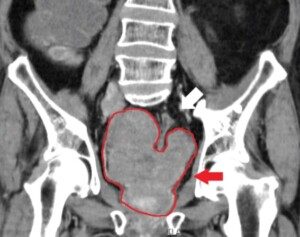Are you afraid of intentional weight loss because you think “weight cycling” is worse for your body than is staying fat?
Let’s take a close look at this issue.
Weight cycling, often referred to as “yo-yo dieting,” is that of repeatedly losing and regaining weight.
It’s a phenomenon that many individuals experience, particularly those who follow severe caloric restriction or gimmicky ways of eating that aren’t sustainable.
The regain may also be triggered by stress eating, even though they had lost weight with a sustainable and healthful approach.
Stable obesity is that of consistent fat body mass without significant fluctuations in weight.
Understanding Weight Cycling
Weight cycling typically involves a pattern of weight loss followed by a regain, which can be seen in individuals who engage in intermittent dieting.
This can occur for a variety of reasons such as unsustainable dieting habits (Stiegler & Cunliffe, 2006).
Many say that “diets don’t work.” The diet for weight loss that’s most likely to “not work” consists of either severe caloric restriction that leaves a person feeling deprived and with ongoing and distracting hunger, or, the diet that “doesn’t work” is unrealistic to stick to long-term.
An example would be cutting out all bread, pasta and potatoes.
Two more examples would be trying to eat 120 grams of protein and only 50 grams of carbs per day, or cram all of one’s food intake into six hours per 24 hours.
The weight cycling may occur beneath the person’s highest weight.
For example, a woman’s highest weight is 185 pounds.
When she attempts weight loss, she gets down to 150.
But then she “loses control” and gets up to 170.
This gain of excess fat due to overeating fires up her motivation and she drops back down to 150.
Over an extended time her weight oscillates between 150 and 170.
If she were to give up entirely, though, her weight would stabilize out at 185.
So which is better for her body: zipping back and forth between 150 and 170? Or staying at 185?
A different way to view this is if the top weight is 250 on her 5’5 frame.
This is the result of giving up on intentional weight loss. Her very high caloric intake keeps her body at 250.
But weight loss attempts will get her down to 150. She can’t stick to the new plan and eventually her weight creeps up to 200.
Which is worse for her body?
Weight cycling between 150 and 200 pounds?
Or just tossing in the towel and thus staying steady long-term at 250 pounds on her 5’5 frame?
We also need to consider the real possibility that when one gives up with the intentional weight loss, their “highest” weight could eventually begin climbing even higher, since metabolism slows down with age.
That highest of 250, then, may in time become 300.
Stable Obesity: A Dangerous but Consistent Condition

Freepik.com
Obesity is a well-established risk factor for several chronic diseases, including type 2 diabetes, cardiovascular disease, hypertension and certain cancers (Haslam & James, 2005).
Obese individuals who claim they’re healthy (now) because they have normal blood work need to consider their weight’s impact on their joints, mobility and stamina as they get older. Plus increased risk of some cancers (can’t say that enough).
The health risks associated with stable obesity are profound.
The health risks of stable obesity are profound.
Excess body fat, particularly visceral (around the organs), increases bodywide inflammation and insulin resistance, leading to metabolic diseases (Shaw et al., 2006).
Chronic and stable obesity can lead to a diminished quality of life, decreased mobility, inability to move quickly and increased healthcare costs.
Notably, obesity has been associated with a shorter life expectancy, and the longer an individual remains obese, the more likely they are to develop complications like cardiovascular disease (Lavie et al., 2009).
Does weight cycling pose a greater risk?
Research suggests that weight cycling may not be as harmful as once thought.
In fact, some studies indicate that the risks associated with weight cycling may be less severe than those of prolonged obesity.
Look at it this way: What, logically, is less harmful to your knee joints?
#1 Weighing in at 280 all the time?
#2 Or sometimes weighing at 280 but sometimes also getting as low as 190?
This question can also apply to the feet, since a heavy body can cause a painful foot condition called plantar fasciitis.
It can also be applied to acid reflux, low back pain and strain on the heart.
Metabolic Effects of Weight Cycling
While it’s true that frequent dieting can reduce resting metabolic rate (RMR) over time, particularly in cases of extreme caloric restriction, weight cycling doesn’t necessarily result in permanent metabolic damage.
This would be especially true if one engages in intense strength training to maintain metabolically active muscle mass.
Research by Thomas et al. (2014) found that, while weight cycling might cause short-term reductions in metabolic rate, these effects are typically reversible after the individual returns to a more stable and lower weight.
In contrast, stable obesity is associated with a consistent state of metabolic dysfunction, including persistent insulin resistance, impaired glucose tolerance and higher levels of fat tissue (Kearns et al., 2017).
Very overweight people may experience a prolonged, low-grade inflammatory state that is difficult to reverse without significant weight loss.
A study by Safford et al. (2008) found that weight cycling did not significantly increase the risk of mortality compared to stable obesity.
While men and women who’ve experienced weight fluctuations had a higher risk of cardiovascular events (when compared to a stable healthy weight), this was less pronounced than in those who remained obese.
This suggests that consistent fatness would have more long-term detrimental effects than would intermittent weight cycling.
Effects on Cardiovascular Health
Stable obesity is a well-known risk factor for high blood pressure and coronary artery disease (Lavie et al., 2009).
A lot of excess body fat causes higher levels of blood lipids and blood pressure, both strongly associated with clogged arteries.
Research examining the cardiovascular risks associated with weight cycling, however, has produced mixed results.
A study by Wing et al. (2011) suggested that weight cycling does not exacerbate cardiovascular risk as much as long-term obesity does.
While weight fluctuations can lead to increased blood pressure and lipid levels during weight regain periods, these effects do not appear to be as pronounced as the chronic risk factors associated with consistently remaining obese, particularly morbidly.
On the other hand, other studies have found that weight cycling may contribute to increased arterial stiffness, a risk factor for heart disease (Donnelly et al., 2012).
While this remains an area of ongoing investigation, it seems clear that stable obesity presents a greater and more consistent threat to cardiovascular health compared to the cyclical weight fluctuations seen in dieting individuals.
Must you choose between only weight cycling and staying fat?
There’s a third possibility: stable healthy weight.
You’re far more likely to achieve this under the following circumstances.
#1 You take up intense strength training to build lean, metabolically active muscle mass.
Muscle is the body’s furnace. More lean muscle tissue = faster resting metabolism.
#2 You take up aerobic exercise that includes two sessions per week of HIIT: high intensity interval training – which will fire up your resting metabolism.
#3 You adhere to a realistic, sustainable food intake. This means your favorite foods ARE allowed. Portion control is key.
Over time you can work on reducing your intake of ultra-processed foods.
So it’s not about cutting bread out entirely if you love bread (this would be unrealistic and can lead to a bread binge).
It means choosing “heavy” whole grain bread with seeds, over white squishy bread that has an ingredients list a mile long.
#4 Avoid eating for the wrong reasons such as just because you’re at your computer or someone at work brings in donuts and everyone around you is eating them.
#5 I’d always tell my personal training clients this: “Focus on being strong, fast, energetic and healthy.”
This means sticking to aerobic and strength training workouts NO MATTER WHAT, and eating mindfully rather than mindlessly.”
NEVER GIVE UP! There’s nothing inspirational about quitting.
 Lorra Garrick is a former personal trainer certified by the American Council on Exercise. At Bally Total Fitness, where she was also a group fitness instructor, she trained clients of all ages for fat loss and maintaining it, muscle and strength building, fitness, and improved cardiovascular and overall health.
Lorra Garrick is a former personal trainer certified by the American Council on Exercise. At Bally Total Fitness, where she was also a group fitness instructor, she trained clients of all ages for fat loss and maintaining it, muscle and strength building, fitness, and improved cardiovascular and overall health.
.










































